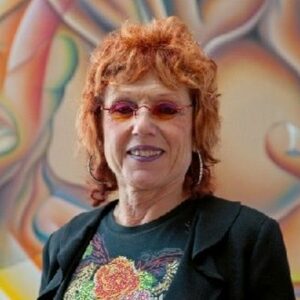Judy Chicago is a well-known feminist artist in the United States. Judith Sylvia Cohen was her real name. Because of her strong attitude and Chicago accent, galley owner Rolf Nelson dubbed her ‘Judy Chicago.’ She coined the phrase “feminist art” and founded the United States’ first feminist art program. Judy was honored for her geometric shape sculptures. Painting on porcelain and airbrush painting on car hoods are two of her artistic endeavors. Her work involving performance art and the use of fireworks is truly remarkable. From the early 1970s, feminist themes dominated her work. She was chastised for a number of her artworks. Critics have called her “Dinner Party,” which features 39 mythological and historical women characters, Utopian and filthy. Her “The Birth Project,” which includes over a hundred needlepoint designs, focuses on women’s experiences with childbirth. Her Holocaust-themed artwork, which depicts the painful experience of concentration camp prisoners, sparked outrage among the Jewish community. She has written several books, including “Beyond the Flower: The Autobiography of a Feminist Artist” and “Through the Flower: My Struggle as a Woman Artist,” in addition to creating art.
Childhood and Adolescence
Judy Chicago was born Judith Sylvia Cohen in Chicago, Illinois, the daughter of Arthur and May Cohen. Her mother was a medical secretary and her father worked at a post office.
Since she was a child, her father’s strong membership in the American Communist Party and his way of thinking inspired her greatly. Her father was the one who instilled in her liberal attitudes on women.
Judy’s mother instilled her love of art in her daughter as a true art lover. She began drawing at the age of three. She enrolled in the Art Institute of Chicago at the same time.
She later enrolled in the University of California, Los Angeles (UCLA), where she was an enthusiastic student. She worked with the National Association for the Advancement of Coloured People (NAACP), an African-American civil rights group in the United States, where she created posters.
She gradually assumed authority as the NAACP’s corresponding secretary. She graduated with a Bachelor of Fine Arts degree in 1962. During this period, she was inducted into the Phi Beta Kappa Group, a prestigious academic honor society in the United States. UCLA awarded her a Master of Fine Arts degree in 1964.
Career of Judy Chicago
Her spherical acrylic plastic dome sculptures and drawings were on display at the Pasadena Art Museum in 1969. She experimented with performance art using explosions and pyrotechnics around this time.
She worked as a full-time teacher at Fresno State College with the goal of teaching women artistic talents. She developed the first feminist art program in the United States for this goal.
She then went on to teach at the California Institute of the Arts, where she led the Feminist Art Program. She was a key figure in the founding of Womanhouse, a feminist art installation and performance space in 1972, as part of this program.
She co-founded the Woman’s Building the following year. The Feminist Studio Workshop was housed in this building, which promoted feminist art. This structure played an important part in the women’s movement.
While working on the Holocaust theme in the middle of the 1980s, she acquired an interest in masculine strength. She toured all of the concentration camps in Eastern Europe and Israel to get ideas for her work.
“The Holocaust Project: From Darkness to Light” featured sixteen large-scale pieces by her. She used tapestry, stained glass, metal and wood work, painting, stitching, and photography to create these large-scale pieces.
In October of 1993, she showed this work for the first time at the Spertus Museum in Chicago. Following that, she worked for the following six years on a piece that represents the horrifying experience of concentration camp victims.
Major Projects of Judy Chicago
In 1969, she invented the “Pasadena Lifesaver.” She created a series of abstract paintings in which she successfully combined colors. She presented her ideas about women’s sexuality and portrayal through four circular forms in this piece.
From 1974 until 1979, she worked on “The Dinner Party,” a magnificent piece of art. It’s an installation piece that depicts 39 legendary and historical female figures.
From 1980 through 1985, she was occupied with “The Birth Project,” another notable creation. A superb blend of painting and embroidery can be seen in it to show women’s ability to give birth.
From 1985 through 1993, she worked on “The Holocaust Project: From Darkness to Light.” Her concern in the Holocaust and masculine dominance is seen in this piece. This piece of art depicts Holocaust victims.
Personal History and Legacy
She fell in love with Jerry Gerowitz while attending UCLA and married him in 1961. Jerry was killed in a vehicle accident in 1963. She was distraught by the occurrence, and she began to experience identity issues as a result.
She used an abstract painting titled “Bigamy” to represent her husband’s death. Several of her male professors were shocked after seeing this piece of art. Later in her career, she used ice sculpture to portray the same concept.
She married for the second time in 1965, this time to sculptor Lloyd Hamrol. In 1979, they divorced.
She married photographer Donald Woodman in 1985.
Estimated Net Worth
The estimated net worth of Judy Chicago is unknown.
Trivia
This powerful artist’s mother refused to talk about her father’s death after he died, and she was not allowed to attend the funeral. She was hospitalized for a month as a result of her unresolved grief, which culminated in a bleeding ulcer.


